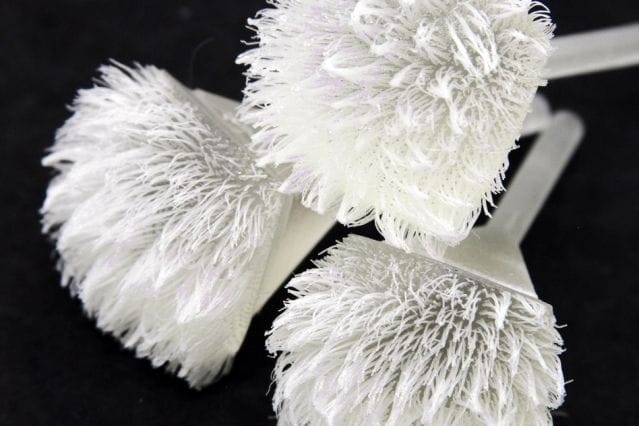![3D printed hair-like metamaterials [Source: MIT]](https://fabbaloo.com/wp-content/uploads/2020/05/image-asset_img_5eb09aec058d8.jpg)
Researchers at MIT have developed yet another unusual metamaterial, and this one is simply hair.
We’ve seen some experiments in 3D printed hair previously, but those were essentially for fun and artistic merit. Those experiments used extrusion movements to pull strands from the nozzle, leaving thin and flexible hair-like structures that could be rearranged at will.
The MIT researchers are doing something quite different, and a lot more functional.
The research is from 2016, and shows great promise for more to come. They realized that hair-like structures could in fact be metamaterials, unusual shapes that implement physical function without requiring power for moving parts. The problem was that to create a CAD design of thousands of tiny hair structures would be extremely tedious and time-consuming.
Their research involved creating a specialized CAD system (called “Cillia”) that could easily generate large numbers of digital hair structures, each with potentially slightly different attributes. They were able to vary length, width and angle of orientation using their newly developed tools to create highly sophisticated hair designs.
Initially their tool was able to generate hair structures on flat surfaces only, but later, more advanced versions were able to generate them on curved surfaces.
These generated 3D models could then be physically produced on 3D printers with appropriate resolution.
Then the fun begins. It turns out that hair structures, if carefully designed, can implement useful mechanical functions. For example take a look at this hair surface, which seems to be directing a small object in a circular path:
![Hair-like metamaterials driving an object in a circular path [Source: MIT]](https://fabbaloo.com/wp-content/uploads/2020/05/image-asset_img_5eb09aec9e45c.gif)
What’s going on here is that the hairs are oriented at a particular angle, and when the arrangement is vibrated slightly, the object tends to move along the same direction as the hairs. In this case, the hairs are angled successively in a circular pattern, thus creating a method to move an object in a circular path.
There’s more.
The researchers were able to design a sophisticated hair surface that was able to sort coins. This structure was similar to the one above except that they varied the strength of the hairs so that some hairs would only be bent by heavier coins. By arranging an appropriate sequence of hair directions, they were able to develop a non-mechanical coin sorting system.
They were also able to produce a Velcro-like surface, which provides temporary adhesion between objects as seen here:
![A 3D printed Velco-like system [Source: MIT]](https://fabbaloo.com/wp-content/uploads/2020/05/hair-velcro-small_img_5eb09aed44ad7.gif)
I say we are seeing here a new class of metamaterials that could be used in a variety of ways in industry, many of which have yet to be discovered.
It seems to me that the designs for metamaterials we have been seeing recently are merely the tip of a gigantic iceberg. There are no doubt thousands and thousands of yet undiscovered meta-material designs that could be 3D printed.
At some point there should be a kind of master catalog of these metamaterial designs so that future designers can pick and choose building blocks for sophisticated equipment designs, in much the same way we today see libraries of open source software that are used in combination to create much of the incredible software universe we live in today.
Via MIT











A research thesis details the incredibly complex world of volumetric 3D printing. We review the highlights.